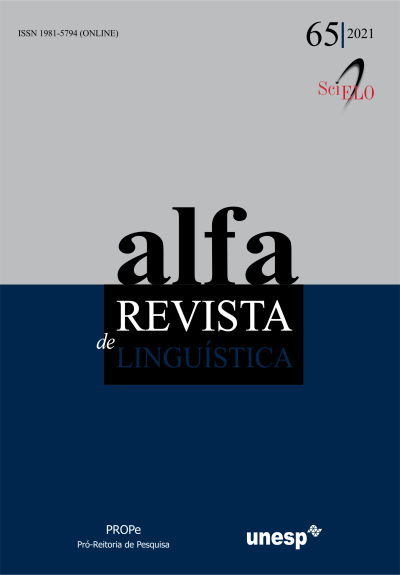Discontinuous Noun Phrases
DOI:
https://doi.org/10.1590/1981-5794-e13282Keywords:
noun phrase, discontinuity, focusAbstract
The phenomenon this paper focuses on is the noun phrase (Np) that presents non-canonical order of its constituent parts, called “discontinuous” by Keizer (2007). The analysis and description of discontinuity aims to examine which pragmatic, semantic and formal factors motivate the speaker’s choice to encode specific orderings to these Nps at the Morphosyntactic Level based on the theoretical framework of Functional Discourse Grammar (HENGEVELD; MACKENZIE, 2008). The sample is constituted from spoken language records from the Iboruna database, which represents the spoken variety in the northwest of São Paulo State, collected by the ALIP project, within the Functional Grammar Research Group, at UNESP, in São José do Rio Preto. For the purposes of this work, the following criteria are explored: (i) motivation for discontinuity; (ii) type of intervening material in the Np; (iii) morphosyntactic configuration of the discontinuous Np; and (iv) structural weight of the element displaced from the Np. The analysis shows that discontinuity is predominantly motivated by pragmatic aspects, in particular, by the focal status of information provided by part of the Np. Furthermore, the prototypical discontinuous Np is characterized by the interference of morphosyntactic material between the head noun and its postnuclear constituents. Although there is this linear distancing, the comprehension of discontinuous statements is not impaired due to a semantic link preserved at the Representational Level, a possible interpretation in a theoretical model such as FDG.
Downloads
Downloads
Published
How to Cite
Issue
Section
License
Copyright (c) 2021 ALFA: Revista de Linguística

This work is licensed under a Creative Commons Attribution 4.0 International License.
Manuscripts accepted for publication and published are property of Alfa: Revista de Linguística. It is forbidden the full or partial submission of the manuscript to any other journal. Authors are solely responsible for the article's content. Translation into another language without written permission from the Editor advised by the Editorial Board is prohibited.

